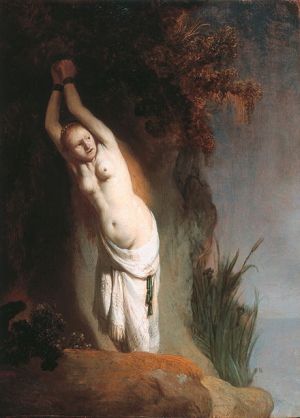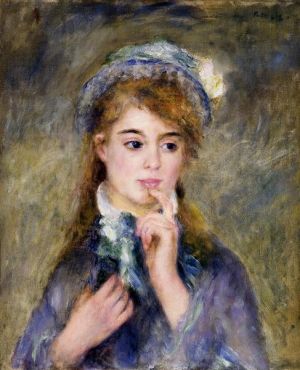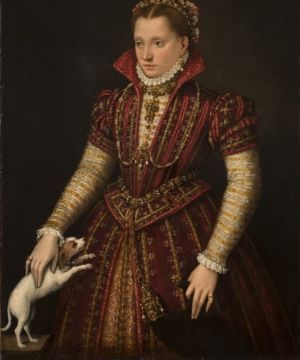Cindy Sherman's Female Archetypes
At its most basic definition an archetype is a communally accepted and widely recognized "typical" example of a person or thing that dwells within our universal consciousness. This example then becomes a recurrent symbol in our popular culture stemming from our shared mental landscape. In Jungian regard (Carl Jung), archetypes are informed and created by our common need to organize and define ourselves as human beings. This same need motivates many artists so it's no surprise that the exploration of life via the use of archetypes can be seen time again throughout the course of art history.
For Sherman, this has meant delving into common tropes of being female, and what it means to present the self as something that desires to be seen.
01 The Damsel in Distress

Rembrandt's famous painting depicts a classic example of the damsel in distress, also known as a woman who is placed in a perilous situation awaiting someone to swoop in and rescue her. His focus is on Andromeda from the story Metamorphoses. In mythology, she was the daughter of an Ethiopian king and queen, whose mother was prone to boasting about her daughter's beauty, so much so that the God Neptune punished Andromeda by having her chained to rocks by the ocean and sent a sea monster to torture her. Perseus, the story's hero, discovered the young beauty and made a deal with her parents that he would rescue her if he could be granted her hand in marriage.

Untitled Film Still #48 by Cindy Sherman, 1979
In Sherman's version, we see a lone woman, vulnerable on the side of the road, standing with her suitcase and without a ride, waiting for someone to drive by and assist her. The tones of the photograph are ominous as dark clouds cover a murky sky. Will someone cruise by to save this innocent, white-bloused woman with the unpredictable fate?
02 The Housewife

Beverly Hills Housewife, 1967 by David Hockney
As part of his California Dreaming series, David Hockney painted this portrait of a Beverly Hills housewife strolling through the outdoor patio of her luxury home. The housewife was a common subject throughout the 1960s and '70s as feminism rose to challenge the stereotypes of women whose lives and livelihoods stemmed from their roles within the home. Many narratives were dissected and explored around this archetype, both demeaning and elevating the status of women rooted in domesticity.

Untitled Film Still #3
Sherman's representation brings to mind a decidedly 1950s-era, married woman who stayed at home all day with nothing to do but clean the house and prepare for the return of her children from school and husband from work. This lonely housewife was oftentimes notably bored, relying on the seduction of the postman, or "mommy's little helper" pills to brighten her day.
03 The Ingénue

Renoir's painting plainly presents a portrait of an Ingénue, the term used to describe a youthful, innocent, beautiful, and sometimes naive girl who is admired for those traits alone, oftentimes treated like a muse-type character in books, films, and other cultural offerings. We rarely see past the exterior of this girl and her enthusiasm for being placed in this role also pigeonholes her within it. She often appears as the understudy in a play, or trying to capitalize on her talents and appeal while still young of age.

Untitled Film Still #15 by Cindy Sherman, 1978
Sherman's rendition of a sweet young dancer sitting in reflection mid-rehearsal brings to mind all the bright, young girls who travel to the big city with a pocketful of dreams and stars in their eyes, only to be fed into, and spit out of, the constantly revolving doors of the entertainment machine.
04 The Sex Object

The Doll, 1936 by Hans Bellmer
In the 1930s, the Surrealist Hans Bellmer made a series of disquieting sculptures partly inspired by Jacques Offenbach's opera The Tales of Hoffman in which the main character falls in love with a realistic mechanical doll. Hoffman's dolls were constructed of wood, plaster, metal rods, nuts, and bolts, and eerily portrayed the fetishized eroticization of females and their body parts as mere sexual play objects.

Cindy Sherman, Untitled #264
Over fifty years later, Sherman's delve into the Sex Object archetype conjures a woman whose sole purpose is to serve a man sexually, seen in our contemporary society as an object to be used for sensual gratification above all else. The prostitute, the sex doll, the centerfold, and other ladies of the night, nameless and faceless beyond the utilization of their body parts, which temporarily memorialize her.
05 The Clown

Self Portrait as Clown, 1921 by Max Beckmann
Max Beckman was interested in the world of entertainment and all of the colorful characters found within its milieus: the theater, the circus, and the music halls. In his view, the stage provided a metaphorical setting to explore human relationships and world affairs. One of his most famous paintings is this self-portrait as a clown, a picture that strikes a resonant chord in its allusion to the artist as another form of consummate performer.

Cindy Sherman Untitled #414
The Clown archetype goes beyond the normal female fodder for Sherman and arrives later in her career, emphasizing her role as the ultimate artistic entertainer. With roots in the court jester, this character's existence is marked by the ability to act for an audience's pleasure, with little regard toward her own. It is no surprise that many in the public eye, from artists to actors to politicians, can relate to this archetype.
06 The Society Woman

Lavinia Fontana was a noted painter commissioned by many women of her time to create portraits. It was fashionable in her day for women to seek these vanity paintings to depict momentous occasions in their lives or merely position themselves as ladies of certain social status and acclaim. This painting is a famous example of a marriage portrait. The objects, colors, and imagery depicted are all typical of a highborn bride'strousseau.

Untitled #476
Today, the Society Woman still looms large although pictorial evidence is most often found in the social pages of magazines. Sherman's contribution represents the woman for whom status, social class, and reputation is everything. These modern noblewomen maintain strenuous efforts to appear poised, affluent, and confident at all times despite any underlying hints at their more fragile, vulnerable, or insecure elements of humanity. Often blessed with money, through inheritance or marriage, they are still often commissioners of the vanity portrait to memorialize their lives of privileged position.